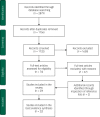Anxiety scales used in pregnancy: systematic review
- PMID: 30762504
- PMCID: PMC6343118
- DOI: 10.1192/bjo.2018.75
Anxiety scales used in pregnancy: systematic review
Abstract
Background: Anxiety disorders and self-reported symptoms are highly prevalent in pregnancy. Despite their negative impact on maternal and child outcomes, uncertainty remains regarding which symptoms can be considered accurate indicators of antenatal anxiety.AimsTo examine and synthesise the evidence in relation to the psychometric properties and content of self-report scales used to detect anxiety symptoms in pregnant women.
Method: A systematic search was carried out and the methodological quality of all included studies was assessed. Only those achieving a rating of good or excellent were considered in a synthesis of the best available evidence.
Results: Several anxiety symptoms and domains were identified as promising for screening for general antenatal anxiety and pregnancy-related anxiety, including elevated levels of worry, symptoms of panic, fear of childbirth and excessive worries about the baby's health.
Conclusions: This review contributes to the existing knowledge by identifying a number of anxiety symptoms that can be considered psychometrically robust indicators of antenatal anxiety.Declaration of interestNone.
Keywords: Pregnancy; anxiety disorders; pregnancy-specific anxiety; psychometric properties; screening.
Figures
Similar articles
-
The effect of weight management interventions that include a diet component on weight-related outcomes in pregnant and postpartum women: a systematic review protocol.JBI Database System Rev Implement Rep. 2015 Jan;13(1):88-98. doi: 10.11124/jbisrir-2015-1812. JBI Database System Rev Implement Rep. 2015. PMID: 26447010
-
Coping strategies as psychological risk factor for antenatal anxiety, worries, and depression among Greek women.Arch Womens Ment Health. 2013 Oct;16(5):353-61. doi: 10.1007/s00737-013-0338-y. Epub 2013 Apr 5. Arch Womens Ment Health. 2013. PMID: 23558945
-
Pregnancy-related anxiety: A concept analysis.Int J Nurs Stud. 2016 Mar;55:115-30. doi: 10.1016/j.ijnurstu.2015.10.023. Epub 2015 Nov 10. Int J Nurs Stud. 2016. PMID: 26626973 Review.
-
Worries surrounding the first ultrasound do not bias the screening for depressive and anxiety symptoms during pregnancy.Aust N Z J Obstet Gynaecol. 2015 Feb;55(1):59-63. doi: 10.1111/ajo.12268. Epub 2014 Oct 22. Aust N Z J Obstet Gynaecol. 2015. PMID: 25339122
-
A systematic review of nonpharmacological prenatal interventions for pregnancy-specific anxiety and fear of childbirth.Birth. 2018 Mar;45(1):7-18. doi: 10.1111/birt.12316. Epub 2017 Oct 23. Birth. 2018. PMID: 29057487
Cited by
-
Prenatal risk factors for child executive function at 3-5 years of age: the roles of maternal mood, substance use, and socioeconomic adversity in a prospective cohort study.BMC Pediatr. 2024 Oct 28;24(1):682. doi: 10.1186/s12887-024-05113-2. BMC Pediatr. 2024. PMID: 39465362 Free PMC article.
-
Prenatal Telepsychological Intervention for Preventing Anxiety: A Study Protocol.J Clin Med. 2024 Oct 2;13(19):5877. doi: 10.3390/jcm13195877. J Clin Med. 2024. PMID: 39407937 Free PMC article.
-
Association between sleep quality with maternal and neonatal outcomes during the covid-19 pandemic.BMC Pregnancy Childbirth. 2024 Apr 19;24(1):294. doi: 10.1186/s12884-024-06479-y. BMC Pregnancy Childbirth. 2024. PMID: 38641830 Free PMC article. Clinical Trial.
-
Correlation Between Maternal Anxiety During Mid-Pregnancy and Subsequent Infant Sleep Issues [Letter].Int J Gen Med. 2024 Apr 4;17:1323-1324. doi: 10.2147/IJGM.S467453. eCollection 2024. Int J Gen Med. 2024. PMID: 38596647 Free PMC article. No abstract available.
-
The prevalence and risk factors of depression in prenatal and postnatal women in China with the outbreak of Corona Virus Disease 2019.J Affect Disord. 2021 Mar 1;282:1203-1209. doi: 10.1016/j.jad.2021.01.019. Epub 2021 Jan 11. J Affect Disord. 2021. PMID: 33601697 Free PMC article.
References
-
- Dennis CL, Falah-Hassani K, Shiri R. Prevalence of antenatal and postnatal anxiety: systematic review and meta-analysis. Br J Psychiatry 2017; 210: 315–23. - PubMed
-
- Heron J, O'Connor TG, Evans J, Golding J, Glover V. The course of anxiety and depression through pregnancy and the postpartum in a community sample. J Affect Disord 2004; 80: 65–73. - PubMed
-
- Dunkel-Schetter C, Lobel M. Pregnancy and birth: a multilevel analysis of stress and birth weight In Handbook of Health Psychology 2 (eds Revenson T, Baum A, Singer J): 427–53. Lawrence Erlbaum, 2011.
-
- Stein A, Pearson RM, Goodman SH, Rapa E, Rahman A, McCallum M, et al. Effects of perinatal mental disorders on the fetus and child. Lancet 2014; 384: 1800–19. - PubMed
-
- Rubertsson C, Hellström J, Cross M, Sydsjö G. Anxiety in early pregnancy: prevalence and contributing factors. Arch Womens Ment Health 2014; 17: 221–8. - PubMed
LinkOut - more resources
Full Text Sources
Medical


